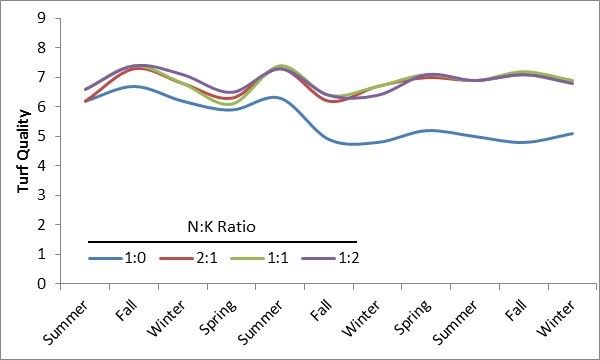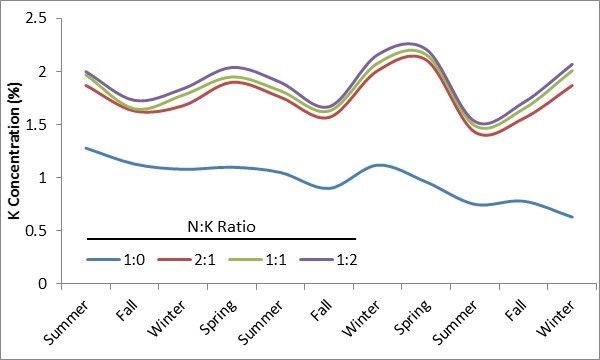Golf course nutrient management programs commonly include the application of both nitrogen (N) and potassium (K). These macronutrients are required by turfgrass in greater quantities than any other element except carbon, hydrogen, and oxygen (Carrow et al. 2001). Soil tests are commonly used to make nutrient recommendations. However, soil test calibration curves have never been developed for parameters other than pH, salinity, and sodicity (the quantity of sodium held in the soil). Soil test values and recommendations for K are of little value in Florida due to the high solubility of K and the low cation exchange capacity of Florida's sandy soils, which reduces the soil's ability to retain K. Potassium retention is further reduced during periods of increased rainfall.
Generally, turfgrasses require half as much K as N (Turgeon 2012). Regardless, many turfgrass managers often apply K in excess of this 2:1 N:K ratio with reports as high as 1:10 (Rowland et al. 2014). This excess potassium application does not result in any environmental concern because K is not an element of impairment, but it does increase management costs. Because it is common to apply N and K in a single application using blended fertilizer, it is of great value to understand the importance of using the most efficient N:K ratio.
Fairways, Tees, and Approaches
Annual N applied to golf course fairways, tees, and approaches should follow the recommendations provided in the current best management practices (Shaddox 2016). Potassium applied to these areas should equal approximately one-half the amount of N. Figures 1 and 2 show that increasing K from a N:K ratio of 1:0 to a ratio of 2:1 increases both the K concentration in turfgrass leaves and the turfgrass quality (Snyder and Cisar 2000). Further additions of K up to a 1:1 N:K ratio may increase leaf K concentrations during certain seasons but does not enhance turf quality. Applications of K above a 1:1 N:K ratio are not evidence-based practices on Florida fairways, tees, and approaches.


Greens
Due to the additional stresses typically encountered by putting green turfgrasses, more K may be warranted on putting greens than on fairways. A 1:1 N:K ratio has been shown to be more efficient than ratios of 1:2, 1:3, and 1:4 on TifDwarf and TifEagle bermudagrass, SeaDwarf seashore paspalum, and Toccoa Green (formerly PristineFlora) zoysiagrass (Rowland et al. 2010). Evidence indicates that increasing K applications on Florida putting greens above a 1:1 N:K ratio does not increase putting green firmness, speed, quality, drought resistance, recuperative potential, root growth, or chlorophyll concentration (Rowland et al. 2014). Additionally, increasing K applications above a 1:1 N:K ratio does not decrease establishment time, thatch accumulation, or mower scalping.
Conclusion
Based on current evidence, the most efficient N:K ratio for fairways, tees, and approaches is 2:1, whereas the most efficient ratio on putting greens is 1:1. Routine applications of K in conjunction with N is currently the most efficient approach to minimizing K deficient turfgrass.
Note: Because fertilizers are labeled as N-P2O5-K2O, a 2:1 N:K fertilizer would be labeled as 20-0-12 rather than 20-0-10 because K on the fertilizer label is listed as K2O rather than K.
References
Carrow, R.N., D.V. Waddington, and P.E. Rieke. 2001. Turfgrass soil fertility and chemical problems: assessment and management. Ann Arbor Press, Chelsea, Mich.
Rowland, J.H., J.L. Cisar, G.H. Snyder, J.B. Sartain, A.L. Wright, and J.E. Erickson. 2010. "Optimal nitrogen and potassium fertilization rates for establishment of warm-season putting greens." Agron. J. 102: 1601–1605.
Rowland, J.H., J.L. Cisar, G.H. Snyder, J.B. Sartain, A.L. Wright, and J.E. Erickson. 2014. "Drought Resistance of Warm-Season Putting Green Cultivars on US Golf Association Root Zones with Varied Potassium." Agron. J. 106: 1549–1558. doi:10.2134/agronj14.0019.
Shaddox, T.W. 2016. Recommendations for N, P, K and Mg for golf course and athletic field fertilization based on Mehlich III extractant. SL 191. Gainesville: University of Florida Institute of Food and Agricultural Sciences. https://edis.ifas.ufl.edu/publication/SS404
Snyder, G.H. and J.L. Cisar. 2000. "Nitrogen/Potassium fertilization ratios for bermudagrass turf." Crop Sci. 40: 1719–1723.
Turgeon, A.J. 2012. Turfgrass management. 9th ed. Prentice Hall, Boston.